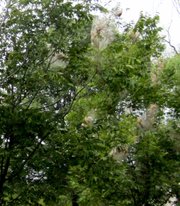Q I have had this [gold dust plant] in a pot for years. It has black leaves so I moved it to a shady spot. Did it just get too much sun and heat?
A The plant is an aucuba, commonly called gold dust plant. It is a shade plant and the leaves will turn black if it gets too much sunlight. It is a great evergreen shrub for the shade.
Q I am attaching a couple of photos of the nests of worms that we have in so many trees in our area. I live in Scott. The tree I am most concerned about is the pecan tree, although I guess we need to control them everywhere. Is there something that we can spray on the trees? When should we spray? How often? Is it safe on pecan trees?
A You have a nice case of fall webworms. In the spring we get tent caterpillars for a few weeks, but in mid- to late-summer we start with fall webworms, and we can have several generations per season. The webs are a tad unsightly, but there is very little damage that occurs to the trees. With webworms, they feed inside the web, making the web larger over time. They primarily eat the leaves, and this late in the year, that doesn't hurt the trees -- look at how many leaves are already falling. If you really dislike them, you can try to use a high-powered spray at the end of your hose and spray with Bacillus thuringiensis (BT), an organic spray. The key is to spray around the web and into it, getting the spray on the leaves. The caterpillars have to eat the foliage and ingest the BT for it to work. If you have small trees with webs close to the ground, you can use a rake to pull down the webs and dispose of them, but don't hurt yourself trying to climb up into a tree to remove them. And don't use the old-fashioned method of burning them out of the trees -- that can damage your trees. The insects (or the BT) will not affect the safety of the pecans. While webworms can attack a wide range of tree species, pecans are one of their favorites. But look on the bright side; Halloween is just around the corner, and you could pretend they are Halloween decorations. They look a bit spooky.
Q I have some Gerbera daisies in clay pots on my back porch. They have been beautiful and bloomed often. Just last week the leaves on the plant all developed what looks like a fungus. I have sprayed Bayer Advance with no improvement. Could you tell me what causes this condition and what to do about it? I have enjoyed the plants for two years. They were in the garage during the winter and even bloomed there.
A Don't expect immediate results from fungicide sprays. Diseases don't happen overnight, and control won't either. Spots won't disappear with spraying, but new growth should come out that is healthy. You don't describe exactly what is happening, but if you have powdery mildew -- a white growth on the foliage -- that can occur with periods of high humidity. If it is leaf spots, that can happen this late in the season when plants are stressed. If only a few leaves are affected, remove them. Lightly fertilize, since the plants have a good couple of months of growth left before you move them back to the garage. Let them dry out a bit in between watering. Gerbera daisies are considered relatively short-lived perennials if left outdoors year-round.
Q I have two varieties of crab apple in my backyard. One of the trees is quite healthy, but the other has had virtually all of its leaves half chewed away. There is no other visible signs of insects or borers. Will this affect the growth? Is there anything that I should be looking for specifically?
A Crab apples can be attacked by a number of diseases and insects, and some varieties are more resistant than others. If the feeding damage occurred recently, don't be concerned. We are nearing the end of the growing season anyway. If you have heavy damage early in the season and it reoccurs each year, that could weaken the tree and make it more susceptible to other problems. Rake up the leaves this fall and start clean next spring. You could also spray the tree with a dormant oil this fall after all the leaves fall off, if repeated damage makes the tree susceptible. Dormant oil smothers out anything that is overwintering on the tree if you get thorough coverage, which would help again with a clean start next year.
Q In March, my daughter and I dug up a variegated lacecap hydrangea. I kept it on my patio in Cleveland County until Aug. 8, when I took it to Georgia, where my daughter moved. What do we do with it now? Do we wait until the fall to plant it or try to plant it now? It is in a giant pot, but the plant is so large that it only has adequate dirt and has to be watered frequently.
A Plant it as soon as possible. The sooner it gets in the ground, the sooner it can start getting its root system established before winter sets in. This will make your life easier too, since it won't be as water needy once it has more room to grow. Give it full morning sun and afternoon shade if you can.
Janet B. Carson is a horticulture specialist for the University of Arkansas Cooperative Extension Service. Write to her at 2301 S. University Ave., Little Rock, Ark. 72204 or email her at
jcarson@arkansasonline.com
HomeStyle on 09/12/2015

